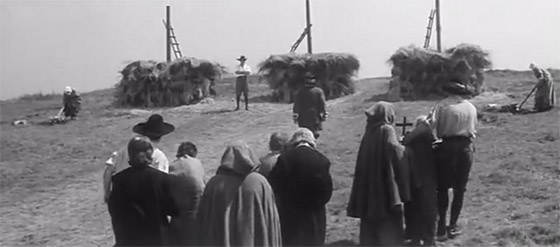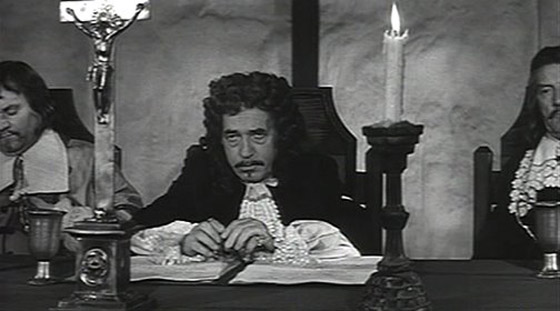
At one point in Witches’ Hammer (1969), Otakar Vavra’s document of a 17th Century witch hunt in the Czech Republic, an accused witch, tied to a stake, screams through rising smoke, “I was made to acknowledge my guilt! I was tortured for nine days.” The Inquisitor, watching the proceedings with the esteemed lady of the estate, assures her, “That’s a lie. She was interrogated with the usual application of thumb-screws and boot. Of course, that’s quite common.” One of the arguments leveled by critics of the Bush/Cheney administration’s “enhanced interrogation techniques” is one that forms the central obsession of Vavra’s powerful film: when someone is tortured, they will say anything. The information should not be acted upon. Furthermore, it is more likely to be inaccurate and spoken only to cease the torture. But what does torture really mean? The Inquisitor, one Boblig of Edelstadt, believes that thumb-screws don’t qualify, but in his own secret court he applies even crueller punishments, so perhaps he only parses the word out of diplomatic respect in the presence of fine persons. Say what you want in the light of day, as long as you can do what you wish at night. The lady certainly doesn’t want to hear any of it. The Bishop, who appointed him, remains aloof and deliberately separate from Boblig’s witch-hunt, only expressing alarm when his friends attempt to defend those who have been accused of witchcraft. Forming an argument about the method of torture is meaningless when the one person in the position to stop it will end the conversation at the mention of the word “witch.” Everyone outside of Boblig’s immediate court clears a path out of fear. Those within, like Boblig himself, indulge in every hypocrisy because they gain the spoils of the hunt.
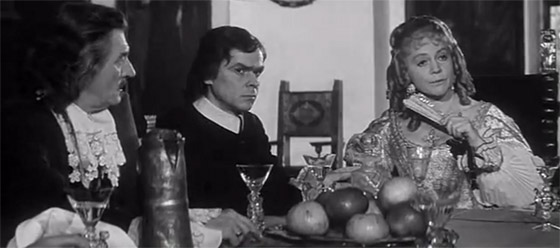
Over supper, the aristocracy discusses appointing a judge to handle an old woman accused of being a witch.
It’s a matter of social climbing, and Vavra might overstate his case, for he has made Boblig the central character of his story, and follows the man from a filth-covered innkeeper (retired from a position as director of Inquisitions) to the most powerful man in the community, wallowing in his greed, throwing feasts for his close friends; meanwhile, they plot to see whose estate they can claim next by accusing the owner of sodomy with Satan at nearby “Peter’s Rock.” Inquisitions are expensive, Boblig carefully explains when he is first interviewed for the job, but Inquisitions pay for themselves, as the witches’ belongings and homes are claimed for the court. When a skeptic scoffs, “A fat lot we’d get out of those beggars,” he makes clear that he has no idea how quickly the flames of a witch-hunt can spread, and how lucrative it can really be. Soon Boblig is deliberately targeting enemies and anyone for whose power or privelege he’s become jealous. Those who express a privately-whispered protest are reassured that Boblig has “forty years’ experience.” And anyone who speaks up to defend an accused is immediately put under suspicion: why would you defend someone in league with Satan, who already has a flock of bloody-thumbed witnesses? “Witch” is the sensitive word. “Witch” is the word to seize power. It might be “terrorist,” or, if that doesn’t grant you what you need, “enemy combatant.” Every law has loopholes. In fact, in one scene the Deacon, the man with the firmest moral integrity in the narrative, and the rare religious man with a deep and studious regard for law and science, pulls one of Boblig’s books from the shelf to directly point out the very loopholes that allow Boblig to torture his accused, promise them cessation and peace if they name names, and burn them at the stake anyway.
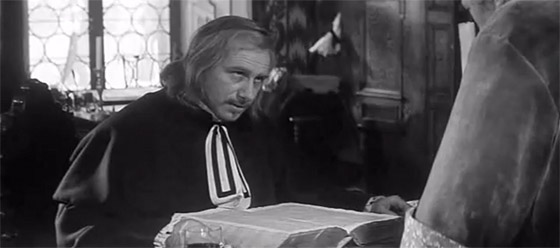
The Deacon reads from the witch-hunter's lawbook, "The Hammer of Witches."
The Deacon is the subject of intense, if unspoken, jealousy by Boblig and others in Velke Losiny because of his ravishing young cook. He’s single, and much is read into their relationship; in fact, much of it is true, but he is still one of the most respected men in the community. He has actually ended their affair to devote himself to his duties as a clergyman, but, as he says late in the film, he will not discuss his relationship with God to the lowly ones who deal with the Inquisitor. He is brought down. First his friends, then the young cook are taken before the court and tortured into confessions. When he is arrested, he asks to see his accusers, assured that they will not lie to his face. In the most compelling scene in the film, each is brought before him, accusing him, then begging for forgiveness. He studies their bloodied limbs, forgives them, and refuses to admit anything to Boblig. Finally, the cook begins repeating the testimony that has been scripted for her by the wardens, but can’t bring herself to address the Deacon directly with the lies; when she sees him, she breaks down. Then the Deacon is taken away.
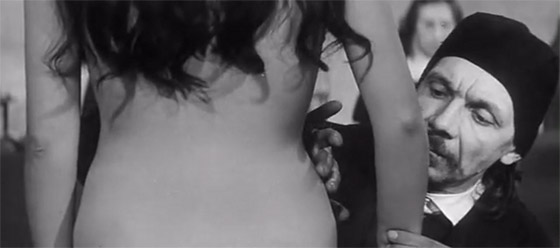
Boblig searches for marks of the devil upon the body of the servant girl he desires.
Vavra is clearly influenced by Carl Theodor Dreyer, but the parallels to The Passion of Joan of Arc (1928) extend from the loving (and economically necessary) use of black-and-white, to the close-ups of anguished faces, and to the fact that much of the courtroom dialogue is taken directly from transcripts. Still, the license of the Czech New Wave allows him to illustrate more explicitly the motivations of the cruel men. He begins with our narrator – a fevered man sitting in a dark cell, describing in sordid and too-fantastic detail the methods of Satan’s disciples – whispering, “Sin reached the world through woman. Woman is sin.” We are quickly shown a woman’s fully nude form slipping out of a bath, and Vavra cuts across this giddy utopia of nude or semi-nude women bathing, gossiping, nursing, laughing. In the early scene in the church, there’s a throwaway shot of a female at worship, her hands folded in prayer squeezing against her chest, while the parishioner standing next to her steals a furtive glance of the moving breasts. Later these passions will be freed for all the priveleged who sit on Boblig’s court, as they leeringly inspect the pretty young cook for the Devil’s mark. While Vavra might initiate you into the sin game in the opening scene, he’s not in the exploitation business; the opening scene is poetic, lively – the later scenes acting as a righteous call for outrage.
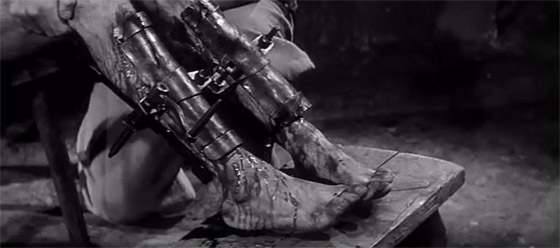
A confession in progress.
Mercilessly, this play happens as it happened, and travels along to its necessary, despairing and cynical end-point. Boblig, rising drunkenly from his banquet table, the others passed out from the orgy, almost addresses the camera when he declares that now no man is above him. Was it all just a matter of wounded ego? In fact, the witch-hunt began in the smallest imaginable manner: an old woman steals away her sacrament in a folded cloth; when questioned by the furious clergymen, she says a witch instructed her to give it to her cow, so that it would give milk again. Although the Deacon tries to assure everyone that local superstitions are common and harmless, he isn’t heeded, and the wheel is set rolling. It can be a bit heavy-handed, as any screed can be, but Vavra’s approach is, for the most part, measured. The film clips along, and he finds ways of sharply defining even minor characters–everyone has a moral crisis, for in the days of a witch-hunt, everyone must choose a side. When Vavra calls for outrage in the film’s final scenes of torture, you’re ready to take your marching orders. There are no witches. The Devil, as the Deacon tries vainly to explain, is only in the hand that harms.
[This essay originally appeared, in slightly altered form, in 2006 on my old blog Kill the Snark.]
